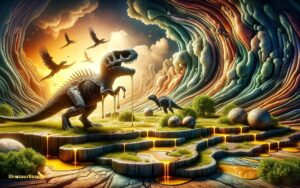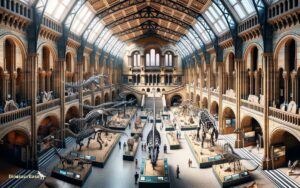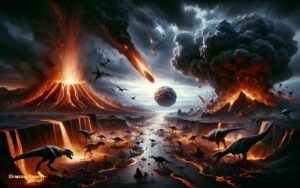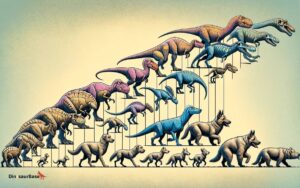Are We Dinosaurs? Unraveling Our Prehistoric Links
No, we are not dinosaurs. Humans and dinosaurs existed in different eras.
Dinosaurs roamed the Earth millions of years ago, long before humans evolved. Humans and dinosaurs are separated by a significant evolutionary gap, with dinosaurs dominating the Mesozoic Era and humans emerging in the Cenozoic Era. Understanding our history on this planet often starts with distinguishing our place in the vast timeline of Earth’s existence.
Our species, Homo sapiens, is a relatively new addition, having been around for just about 300,000 years. This pales in comparison to the reign of the dinosaurs, which lasted about 165 million years. As a result, the Earth’s landscape, climate, and biodiversity have undergone profound changes since the age of the dinosaurs, forming the world we know today.

Credit: www.amazon.com

The Fascination With Dinosaurs
For generations, dinosaurs have captured our imagination. These prehistoric giants roamed the Earth millions of years ago. Yet, their legacy lives on through the fossils they left behind. People of all ages continue to be mesmerized by their sheer size and diversity.
Cultural Impact Of Dinosaurs
Dinosaurs are more than just creatures of the past. They are icons in popular culture. Movies, books, and television shows feature these ancient beasts. They ignite curiosity and wonder in people’s hearts. Museums across the globe showcase their grandeur, fascinating visitors daily.
- Children’s literature and toys: Dinosaurs inspire creativity and learning.
- Film and television: Blockbuster hits, like “Jurassic Park,” bring dinosaurs to life.
- Science and education: Dinosaurs help us understand Earth’s history.
Dinosaurs often symbolize strength and endurance in media. They appear in everything from video games to advertising campaigns. Their influence is truly far-reaching.
Personal Connections To The Prehistoric
Dinosaurs awaken the explorer inside us. Many of us have fond memories of assembling dinosaur puzzles or playing with dino toys. These robust reptiles create a bridge to a world long gone.
| Activity | Connection |
|---|---|
| Fossil digging kits | Stimulate a sense of discovery |
| Dinosaur video games | Offer an interactive prehistoric journey |
| Theme park attractions | Provide immersive experiences |
Parents and teachers use dinosaurs to spark children’s interest in science. Learning about these colossal creatures helps kids grasp concepts like extinction and evolution. Dinosaurs prove that no matter how much time passes, some connections remain timeless.
Unearthing Our Prehistoric Origins
Embark on a journey through time to uncover the roots of our existence. It’s a thrilling adventure to understand how we connect to the mighty dinosaurs of the past. As we dig into the earth, we unravel the secrets of where we come from. Let’s explore the ties that link us to these incredible creatures.
Fossil Record And Human Evolution
Fossils are nature’s time capsules. They lock away stories from millions of years ago. Bones, footprints, and even DNA get trapped in rock and soil. We find these clues all around the world.
They tell us about creatures that lived long before us. Some fossils look like bones we have in our bodies today. These similarities hint that we might share a distant relative. Through careful study, scientists map out our family tree.
- Discovery: Each new fossil shapes our understanding of human history.
- Comparison: We compare old bones to ours to find connections.
- Insight: Fossils reveal changes over time, showing us evolution in action.
Genetic Heritage And Dinosaur Dna
DNA is like a recipe for building living things. It’s passed down from parents to children. Dinosaurs had DNA, just like us.
Scientists study ancient DNA to learn about prehistoric life. Sometimes they find links to creatures alive today. Birds are dinosaurs’ closest living relatives. They share many genes with them.
Birds: Feathers and beaks are features passed down from dinosaurs. Research: DNA tests help us see the connections clearly.
| Dinosaur Features | Bird Features |
|---|---|
| Sharp Teeth | Beaks |
| Scales | Feathers |
| Claws | Talons |
Comparing Human And Dinosaur Anatomy
Delving into our prehistoric past raises captivating questions about the creatures that roamed the earth millions of years ago. The mighty dinosaurs, with their varied forms and features, might seem worlds apart from us. Yet, analyzing the anatomical blueprints shared between humans and these ancient giants can offer remarkable insights into the tapestry of life that threads through time.
Physical Attributes Shared With Dinosaurs
In our quest to comprehend our prehistoric connections, we find striking similarities in physical traits between humans and dinosaurs. Consider the following commonalities:
- Bipedalism: At some point, certain dinosaurs evolved to walk on two legs, a characteristic clearly mirrored in humans today.
- Vertebral column: Dinosaurs possessed a spinal column as do humans, which supports the body’s structure and protects the spinal cord.
- Girdles: Both creatures have pectoral (shoulder) and pelvic (hip) girdles, aiding in limb attachment and movement.
Evolutionary Adaptations Across Eras
Evolution has shaped life across different eras, with changes passed down through generations. Noteworthy adaptations include:
- Thermoregulation: Dinosaurs are believed to have developed ways to manage their body temperature. Humans have sweat glands for this purpose.
- Intelligence: While dinosaurs had varying brain sizes, human evolution favored increased brain capacity, enabling complex problem-solving.
- Locomotion: From the cumbersome stride of giant sauropods to the agile gait of humans, the shift in locomotion strategies is evident in the fossil record.
Behavioral Links And Survival Tactics
Unearthing our past often brings up surprising similarities with the giant reptiles that once ruled the earth. In our Behavioral Links and Survival Tactics, let’s explore how our social habits and instincts compare with those of dinosaurs.
Social Structures: Then And Now
Dinosaurs likely had complex social structures. Paleontologists suggest that many dinosaurs lived and hunted in groups. Fossil findings show herds of herbivores moving together for safety. Much like our ancestors formed tribes, these massive creatures also relied on each other for survival.
Today, our society is a web of intricate connections. We form communities, nations, and build families. This need for social bonds runs deep in our DNA, a heritage we possibly share with dinosaurs.
Predatory Instincts In Humans And Dinosaurs
Let’s talk about survival strategies. The dinosaurs had a clear divide: predators and prey. Tyrannosaurus Rex, for instance, was a hunter. Its predatory instincts were key to its existence.
| Dinosaur Predator | Human Comparison |
|---|---|
| T. Rex | Strategist |
| Velociraptor | Team Player |
In humans, these instincts manifest in different ways. We may not hunt for food like the predators of the past, but we do navigate complex social and professional landscapes. We strategize like a T. Rex hunting its prey. We cooperate like a pack of Velociraptors to achieve common goals.
- An athlete competes for victory.
- A business person strategizes to conquer the market.
- A politician campaigns to win votes.
Select traits make us top predators in today’s world. Our ancestors’ survival tactics evolved, but the essence remains. We owe this knack for strategy and teamwork to our long-lost reptilian relatives.
The Extinction Connection
Our history is rich with tales of species lost forever. The greatest of them all might be the dinosaurs. They roamed the earth millions of years ago. What happened to them has lessons for us today.
Scientists believe a massive asteroid struck the earth. This caused dinosaurs to become extinct. We can learn from this event. It is our turn to face challenges.
Lessons From Dinosaur Extinction
Dinosaurs disappeared swiftly after dominating the planet. We can learn much from this event. Here are key takeaways:
- No species is too big to fail.
- Changes in the environment affect all life.
- Survival depends on the ability to adapt.
These lessons remind us of nature’s power. They show us the need for balance with our surroundings.
Human Actions And Potential For Survival
Humans have a huge impact on Earth. Our actions can harm or help our planet. Remembering the dinosaurs, we must act wisely. Take a look at these points:
| Action | Impact |
|---|---|
| Protecting habitats | Supports diverse life forms |
| Reducing emissions | Lessens climate change effects |
| Conserving resources | Prevents scarcity and conflict |
Our ability to adapt and change holds the key to survival. By learning from the past, we can shape a better future. Let’s be the species that lived, not the one that perished.
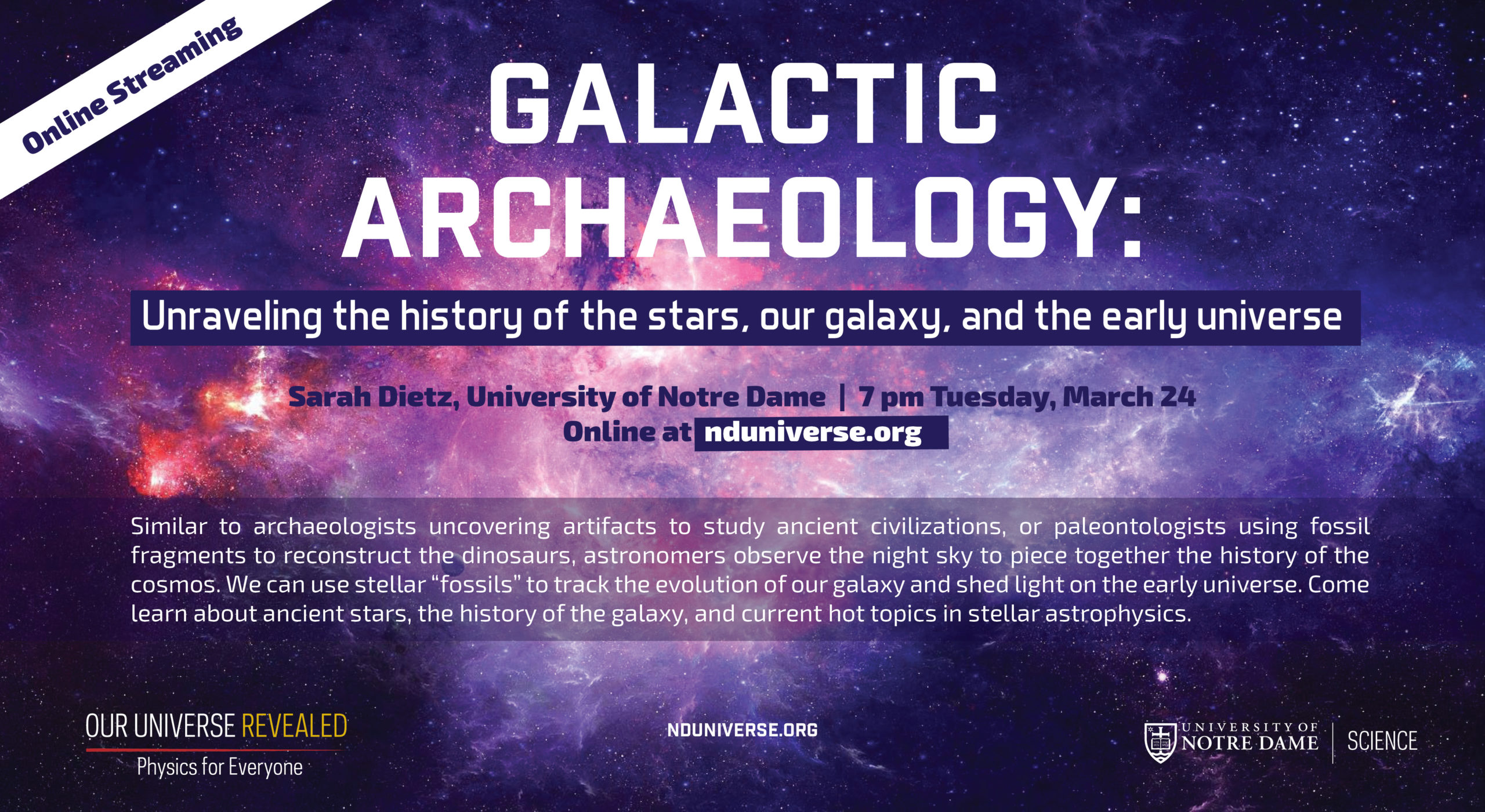
Credit: universerevealed.nd.edu
Preserving The Legacy Of Our Ancient Relatives
Dinosaurs once ruled the Earth, leaving a legacy that fascinates us all. Our ancient relatives might be extinct, but their stories live on through the fossils and footprints they left behind. Preserving the legacy of our ancient relatives is crucial. It helps us understand our planet’s history and the incredible journey of life that predates us by millions of years. Let’s delve into how we keep the memory of dinosaurs alive and inspire future generations.
Paleontology And Its Role In Conservation
Paleontology, the study of ancient life through fossils, is a key player in conservation. It reveals the complex past of life on Earth. This knowledge is not just about building museum collections; it guides us in protecting current ecosystems. Experts in paleontology work tirelessly to unearth the secrets locked within fossils. Their efforts ensure that we conserve not only the physical remains but also the environments once inhabited by these magnificent creatures.
- Uncovering fossils from different layers of earth
- Studying ecosystems and biodiversity of the past
- Using findings to advocate for current habitat protection
Inspiring Future Generations Through Prehistory
The tales of dinosaurs spark wonder in children and adults alike. Stories of the mighty T-Rex or the towering Brachiosaurus open doors to imagination and curiosity. It’s crucial to continue telling these stories to inspire future generations. By bringing the past to life, we encourage young minds to value and protect the natural world.
| Dinosaur | Period | Interesting Fact |
|---|---|---|
| T-Rex | Late Cretaceous | Powerful bite force |
| Brachiosaurus | Late Jurassic | Enormous size & long neck |
| Velociraptor | Late Cretaceous | Known for its speed |
Engaging activities such as dinosaur-themed parks and interactive museum exhibits turn lessons into adventures. These experiences can shape careers in science and conservation. By doing so, we ensure the protection of our world’s history and biodiversity.

Credit: www.amazon.com
Frequently Asked Questions Of Are We Dinosaurs
Do Humans Have Dinosaur Dna?
No, humans do not have dinosaur DNA. Our evolutionary paths are distinct, with dinosaurs having gone extinct millions of years before humans evolved.
What Does The Bible Say About Dinosaurs?
The Bible does not explicitly mention dinosaurs. Its texts predate modern scientific discovery of these creatures by millennia. Some interpret references to “behemoths” and “leviathans” in the Bible as possibly being dinosaurs.
How Did We Go From Dinosaurs To Humans?
Dinosaurs went extinct 65 million years ago after a massive asteroid impact. Over millions of years, early mammals evolved, leading to primates and eventually humans.
Do We Have A Living Dinosaur?
No, there are no living dinosaurs today. Birds are their closest living relatives, having evolved from theropod dinosaurs.
Conclusion
As we contemplate our place in history, it’s clear we’re unique, not relics. Our ability to adapt and innovate sets us apart from the imposing dinosaurs of the past. We carry forward the legacy of survival and progress, continually shaping our future with each new discovery.
Let’s embrace our evolutionary journey with resilience and curiosity.

